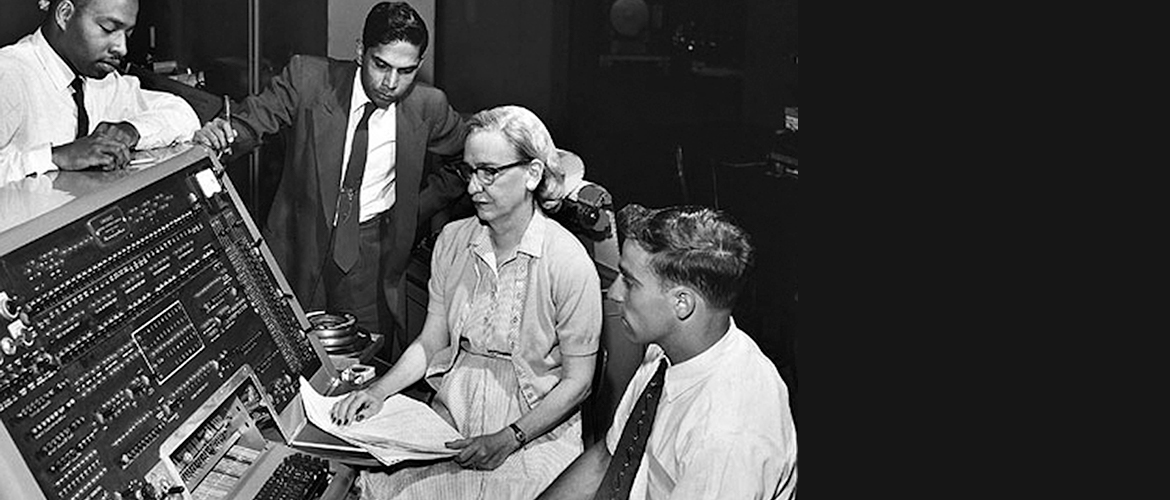No time to read? Listen to the podcast.
If you’re just finishing off the toilet paper and AAA batteries you bought for Y2K, you might be interested in knowing who was behind all the hype, angst, fear, and anxiety in the years leading up to 2000.
It was a woman.
Meet Grace Murray Hopper, Yale Ph.D. (Mathematics, ’34). In 1943, Hopper, then a mathematics professor at Vassar, tried to enlist in the Navy. She was rejected. At 34, she was too old.
She was allowed to join the WAVES, and she looked forward to working as a cryptographer after finishing midshipman’s school. If she had, 1999 would have been notable for the premiere of SpongeBob SquarePants.
Hopper’s Flow-Matic was an incredible breakthrough and was treated as such. With extreme resistance.
Instead, Hopper caught the attention of Howard Aiken, a Harvard physicist who was working on a huge, mechanical automated calculation machine—an early computer—called the Mark I.
Aiken pulled this brilliant, quixotic, and inventive mathematician into his orbit, and Hopper became responsible for preparing the instructions that, when fed into the Mark I, allowed it to compute answers to complex mathematical problems.
The Mark I required programmers like Hopper to organize thousands of instructions, put them in the proper order, and feed them into the Mark I as holes punched in a paper tape. Hopper realized the futility of teaching vast numbers of people to tackle this job, yet as the Mark I was called upon to solve more problems, vast numbers of people were exactly what the project needed.
That’s when Hopper found her passion.
As mechanical behemoths gave way to electronic computers, Hopper set out to make programming accessible to non-scientists. And that led to Flow-Matic, a language that made programming computers less of an intellectual and organizational marathon.
Instead of painstakingly ordering sets of individual instructions such as retrieve the value in storage location 1, increase that value by 10, move the result to storage location 1, Flow-Matic allowed programmers to type out computer programs using English-like statements, such as ADD 10 TO COST.
It was an incredible breakthrough and was treated as such. With extreme resistance.
As a programming prophet, Hopper had to learn to work over, under, around, and through the sexism and inertia that reached from the ranks of the military to the core of American business. According to Jean E. Sammett, an early software pioneer, Hopper “spent a lot of time convincing managers in various companies of the feasibility of Flow-Matic…at a time when this was a unique and generally uncomfortable concept.”*
Hopper succeeded by being both a gifted communicator and a leader who had the courage of her convictions. The old saw, “That’s not how we do it around here,” was never part of her lexicon.
Sorting out fact from folk lore gets a bit messy here, but what is known is that Hopper was instrumental in the development of COBOL, the COmmon Business Oriented programming language, a direct descendant of Flow-Matic.
If there were a time when the Y2K starter’s pistol went bang, this was it.
COBOL became the language of choice for writing programs used by banks, utilities, and insurance companies around the world. COBOL was so universally understood that Hopper once used it to “speak” Japanese.
Separated from her colleagues at a conference in Japan Hopper, who didn’t speak a word of Japanese, found herself surrounded by programmers who didn’t understand a word of English. She went to a chalk board and drew a stick figure of a woman, the word MOVE and a tall rectangle in which she drew little windows and a door. Recognizing the word MOVE as a COBOL instruction meaning “take the item on the left and put it into the receptacle on the right,” one of the Japanese programmers drove Hopper to her hotel.
Few corporations believed that the COBOL programs they developed would be in use for more than four or five years. So, for technical reasons, all those programs reserved only two digits for the year. The prefix 19 was understood. After all, 2000 was a million miles away when measured against the rapidly-changing technology of the 1960s.
Had COBOL been a dud, replaced in the 80s or 90s by some new language, newly-written programs would have defused Y2K. But Hopper and her colleagues did their jobs too well.
COBOL was never eclipsed.
Faced with a digital apocalypse, millions of computer programs had to be rewritten to interpret the digits 00 as the year 2000, not 1900.
At age 80, Hopper retired from the Navy with the rank of Rear Admiral. In addition to her many awards, she was posthumously awarded the Presidential Medal of Freedom by Barack Obama. She died in 1992 without having the chance to party like it was 1999.
She probably would have been first on the dance floor.
Start your Sunday with a laugh. Read the Sunday Funnies, fresh humor from The Out Of My Mind Blog. Subscribe now and you'll never miss a post.
Mind Doodle…
The term bug, to denote an unexpected glitch, was used by Thomas Edison and may date back even further. But the first computer bug was a bug, indeed. It was a 4-inch wide moth that got mashed to death in one of the Mark I’s relay switches. Hopper and her team noted the event in a logbook. Hopper also taped the moth to the logbook page to complete the documentation.
